The Bruce Lee Estate Archive
Senior Product Manager
(2016-2020)
- Design and Productt management including E2E digital experience and implementation of Agile, Double Diamond framework
- Concept iteration, wireframes and user journey flows, rapid prototyping, rapid testing, hifi prototyping (desktop, mobile, wearables).
- Communication with stakeholders (cross-functional up to C-suite level)
- User Research creator; including qual and quant capture and reporting
-
This tool acts as a creative resource given to licensees produce sales in the $1Ms annually on our online store, provided educational resources for exhibitions at the Hong Kong Heritage Museum, The Wing Luke Museum in Seattle, the San Francisco Historical Society, as well as for HBO, ESPN, etc., provided material for the Bruce Lee Foundation, and will be scaled for the larger community embracing Bruce Lee’s legacy and the Estate’s mission.
CASE STUDY
Bruce Lee Archive Digital Experience App
 Why The estate of Bruce Lee has over 14,000 digital assets (and triple physical assets) that it uses for social posts, licensing, museum exhibitions worldwide, and other partnerships. The estate therefore also has a vested interest in being the authoritative source on the life, work, and image of Bruce Lee. Our challenge was defined as creating a storytelling device to activate these assets based on those interests.
Why The estate of Bruce Lee has over 14,000 digital assets (and triple physical assets) that it uses for social posts, licensing, museum exhibitions worldwide, and other partnerships. The estate therefore also has a vested interest in being the authoritative source on the life, work, and image of Bruce Lee. Our challenge was defined as creating a storytelling device to activate these assets based on those interests. Goals To provide great, high-resolution assets including images, film, and sound in a way that connects in a meaningful way to Bruce Lee’s history; to thoughtfully connect Bruce Lee as a martial artist, actor, philosopher, and father to the popular imagination; to curate these narratives in a fresh way that rotates and makes sense over time on desktop, mobile, and wearables, with a concept build out for OTT devices.
Research We did some (admittedly fun) research on how some celebrity archives and estates were taking charge of their materials to drive content and available information. Some of the people we looked at were the Neil Young Archives’ fun and engaging site as well as John Lennon’s official instagram. Neither of these were delivering the quantity and breadth of our vision per se, but the idea was there. Then we looked at some resources well-known for their depth and rigor on the academic research end -- sites like JSTOR, the Getty Archive, or the Smithsonian Archives. This taught us a lot about how to organize growing amounts of information, but they were much fun or very visually-centered. We realized we needed to strike a balance between the two worlds and that visually compelling presentation was going to be key.



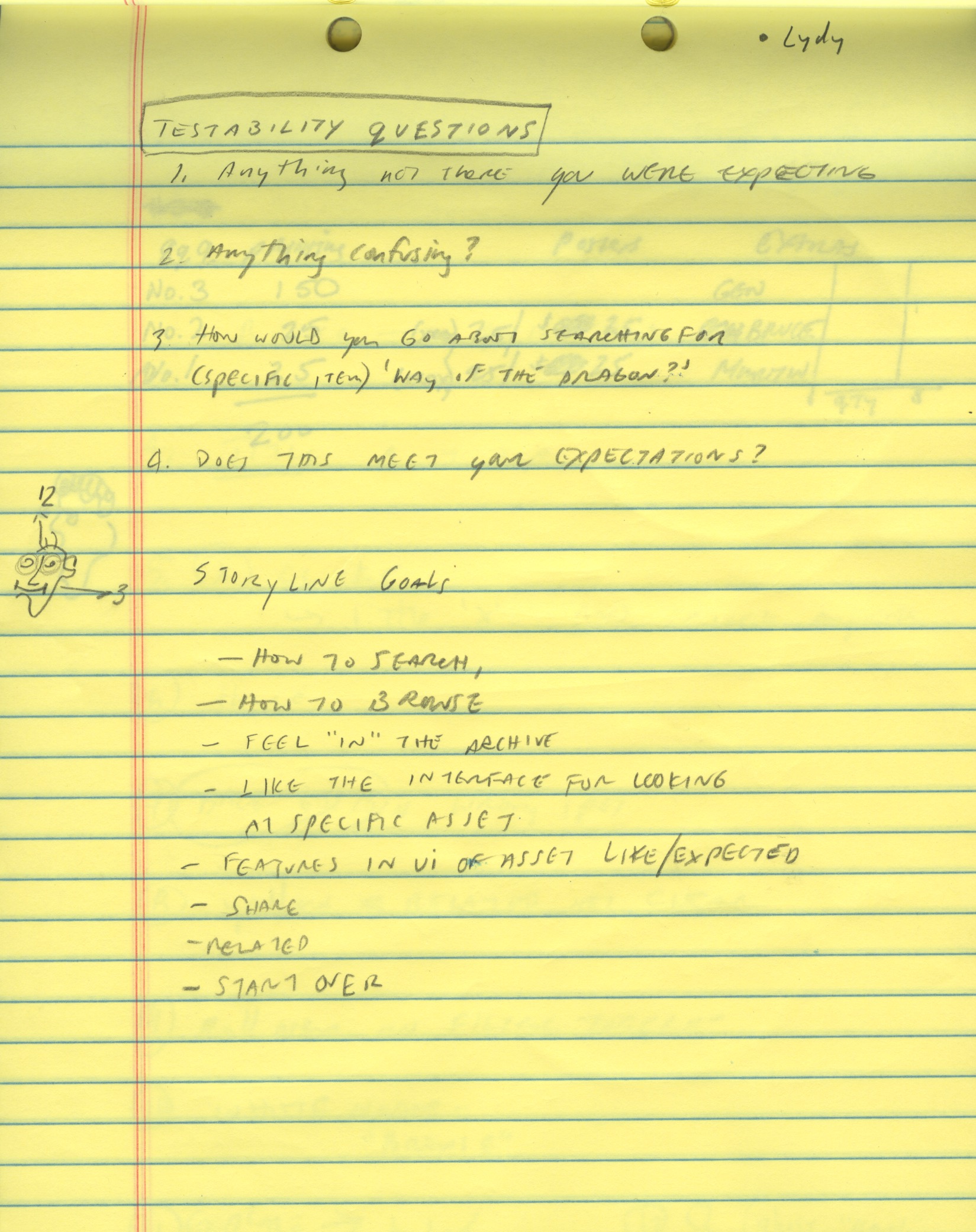
User Testing Strategy Meetings were arranged with stakeholders to firm up prototypes and iterations and balance these ideas with realistic deliverables given the small size of our in-house content creators. How many assets did we want to share publicly? Would it be browsable or meant for research? Could it be both? Would it be fun? Was there an opportunity for paid upgrade feature? We created several personas based on limited but reliable data from our online store. 73% of our online store traffic came from our social (over 20M fans across Instagram, X, and FB/Meta) so we were able to put up a questionnaire gathering data on our users’ location, age, sex, income, and self-identified Bruce-expert level that received 2,000 responses. From this information we built out some reliable general-fan personas.
Next we conducted testing with two important groups in the top teir of the general public: (1) our already-established ‘social micro-influencers’ which were 32 high-quality users who have 2,000+ followers on their Bruce Lee-fan social pages) and (2) Thirteen high-quality licensees who routinely engage in Bruce Lee licensing deals netting profits for the Estate annually. These articulated users vetted the fun-factor, the in-the-know-fan-factor, and the is-there-a-need-factor for the public archive. From there we polished concept and designs and took the browsable feature and the ‘My Archive’ feature to UserTesting.com and conducted these as unmoderated A/B tests and concept tests.
Adapting to Challenges After some user testing and more in-depth beta testing with micro-influencers we were able to keep topping up new content in the archive to see what sank or swam. It was during this period that we decided to shift the design to a more clear navigation of the objects. Because this project is working so closely in tandem with a physical project (a growing archive), a lot of the design issues sprung from bringing something like that to life: limitations of creating content; not overwhelming the casual observer with vast choices; delivering points of interest to the avid fan; organizing everything as both discoverable and adventuresome.
One of our original challenges (mentioned above) was that with over 14K individual digital assets (and growing) in the Bruce Lee Estate Archive, how do we present this stuff in a way that feels more visual than a dry online library collection, but still gives the user as sense of asset connectivity at a glance? How could this be as visual as Flickr or Are.na but as educational as the Library of Congress or JSTOR? We decided to research more closely how the archive was physically organized and figured out a way to simplify their taxonomy.

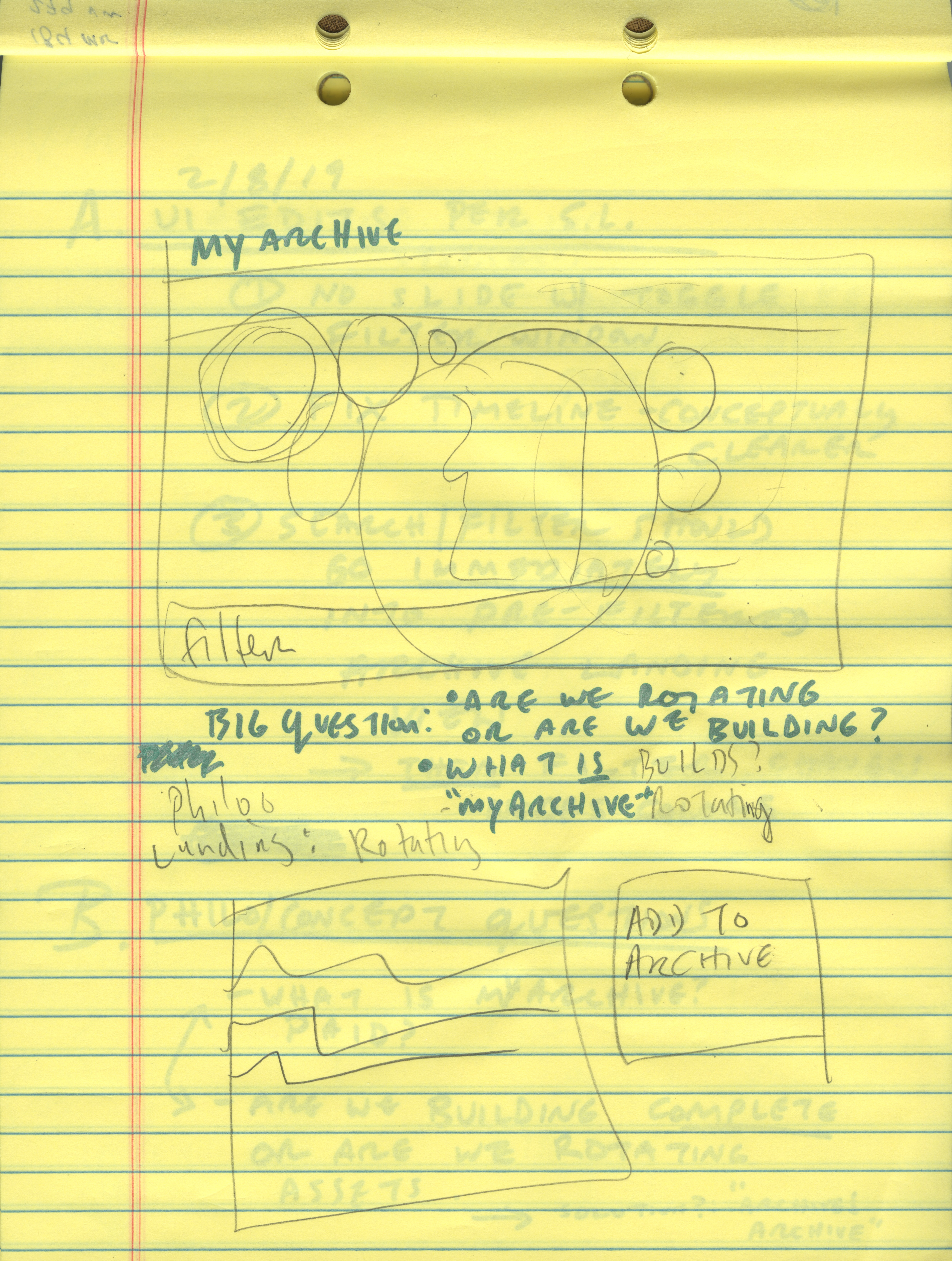
Feature Development Documents, Images, personal daytimer diaries as Calendars, and three-dimensional Objects. If a user was on the hunt for Bruce Lee’s boxing gloves, s/he could find them using some smaller categorical breakdowns in tagging, like “1960s” “1970s” or “Training”. Now, if a user stumbled across those gloves but wondered why Bruce wrote “JKD” on the cuff, we wanted to use the full resources of the archive to show that history--this was essentially the interesting bit of the archive, right? So we also created a Stories section which could (1) satiate the casual browser, and (2) meet the needs of the knowledgable fan who wanted a deeper look at the story of the gloves in the contect of Bruce Lee’s life. (* The letters J-K-D, by the way, stand for Jeet Kune Do, or no way as way: a non-style of martial arts developed by Bruce Lee in the late ‘60s.)

Another challenge was mitigating a lot of variation in verifiable information within the assets. This posed a problem for standardizing tagging for both our back-end and the case of a user searching for related items. Again, we went back to the physical archive and simplified its process for organizing; we found both location and year were mutually re-inforcing bits of metadata according to the unique history of Bruce Lee’s life: we had a month-by-month breakdown of his life once he began his first martial arts school in Seattle in 1960. Luckily, the vast majority of items we would be presenting fell between 1960 and his passing in July 1973. We created a dynamic timeline at the top of the window to orient the user as to where s/he was in the history and give some context to a related asset within The Stories, like a short poem. Other identifiers like Bruce’s location (which was somewhat limited to Hong Kong, Los Angeles, Seattle, and the Bay Area) could also positively cluster together different martial arts schools, film and television work, et cetera. From there we could breakdown several keywords and milestones that fans were likely to search by like film titles, co-stars, fight demos, family members,et cetera.
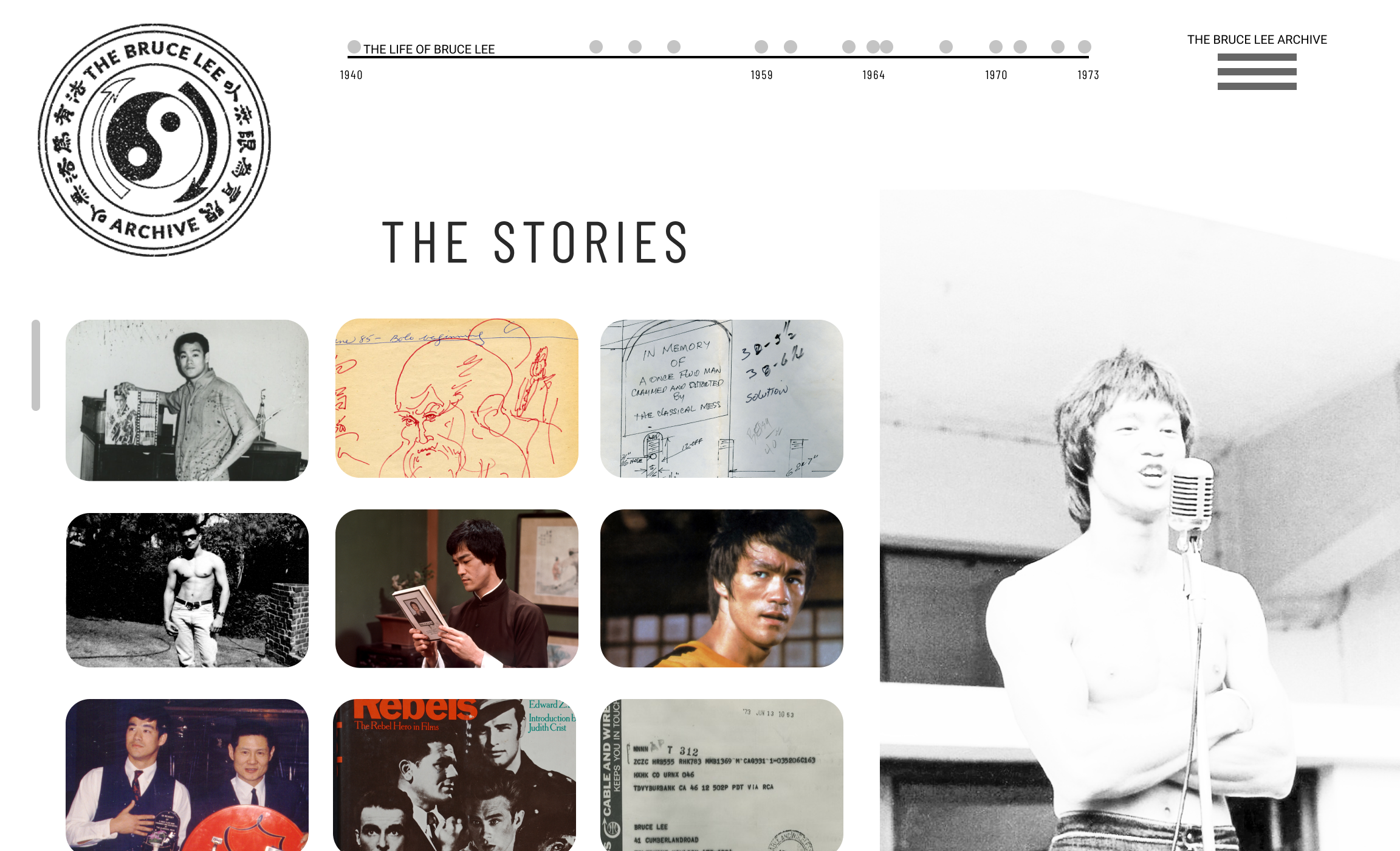 Peeling back to the mode and intuitive nature of viewing assets: we had a challenge in interweaving and correlating information in a way that is not always ‘like’ or ‘linear’ but is indeed related. We wanted this work almost like an annotated version of a well-loved book. Take a look at the example below of the telegram to Bruce Lee from Warner Brothers studio executive Ted Ashley about the title ‘Enter the Dragon’.
Peeling back to the mode and intuitive nature of viewing assets: we had a challenge in interweaving and correlating information in a way that is not always ‘like’ or ‘linear’ but is indeed related. We wanted this work almost like an annotated version of a well-loved book. Take a look at the example below of the telegram to Bruce Lee from Warner Brothers studio executive Ted Ashley about the title ‘Enter the Dragon’.
There’s a lot of information packed into this short paragraph that can lead to other groupings of Bruce Lee history. These soft red ‘hot spots’ could be toggled on-off and allowed us to indicate a new layer of resources available to the curious user (see below).
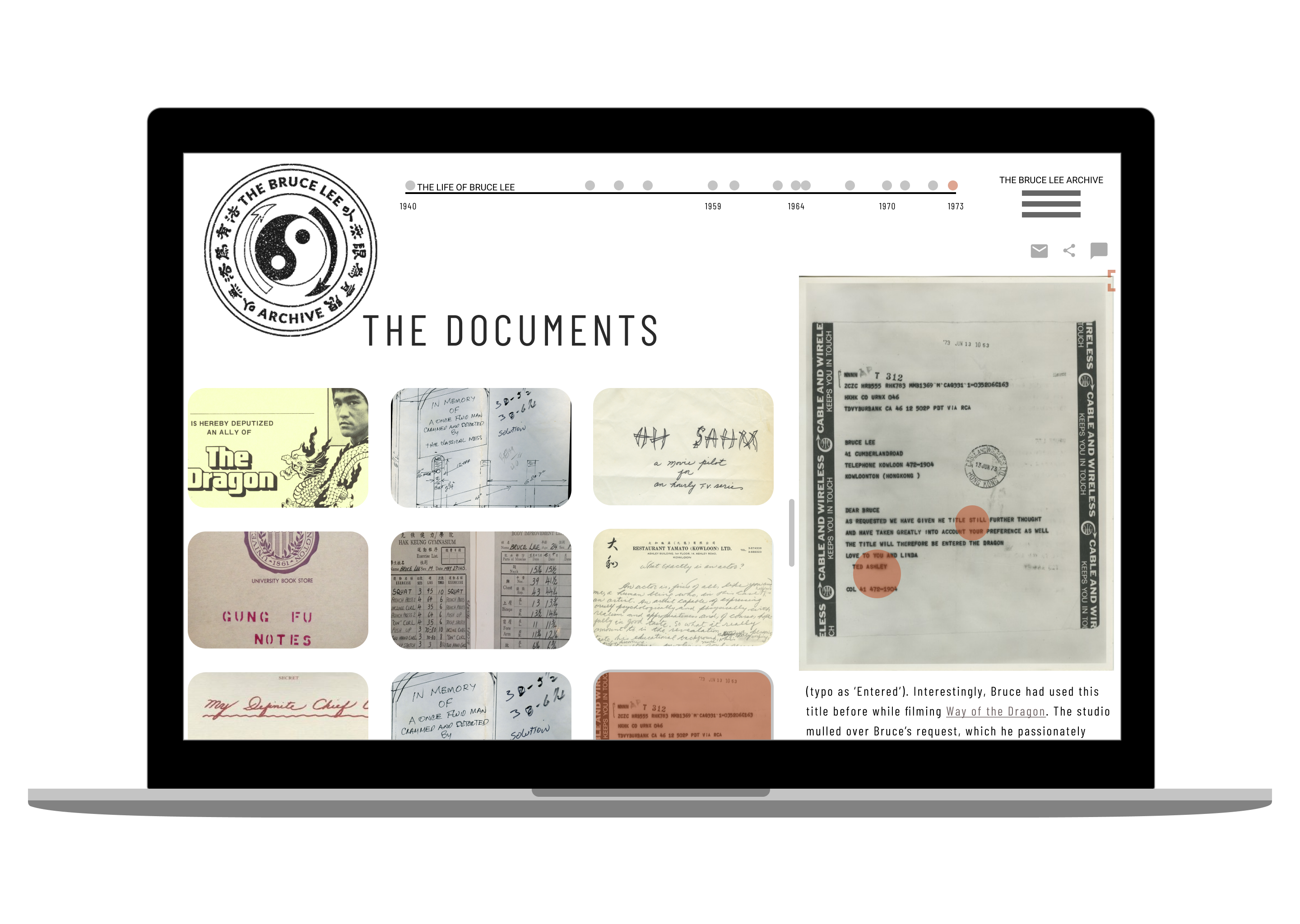
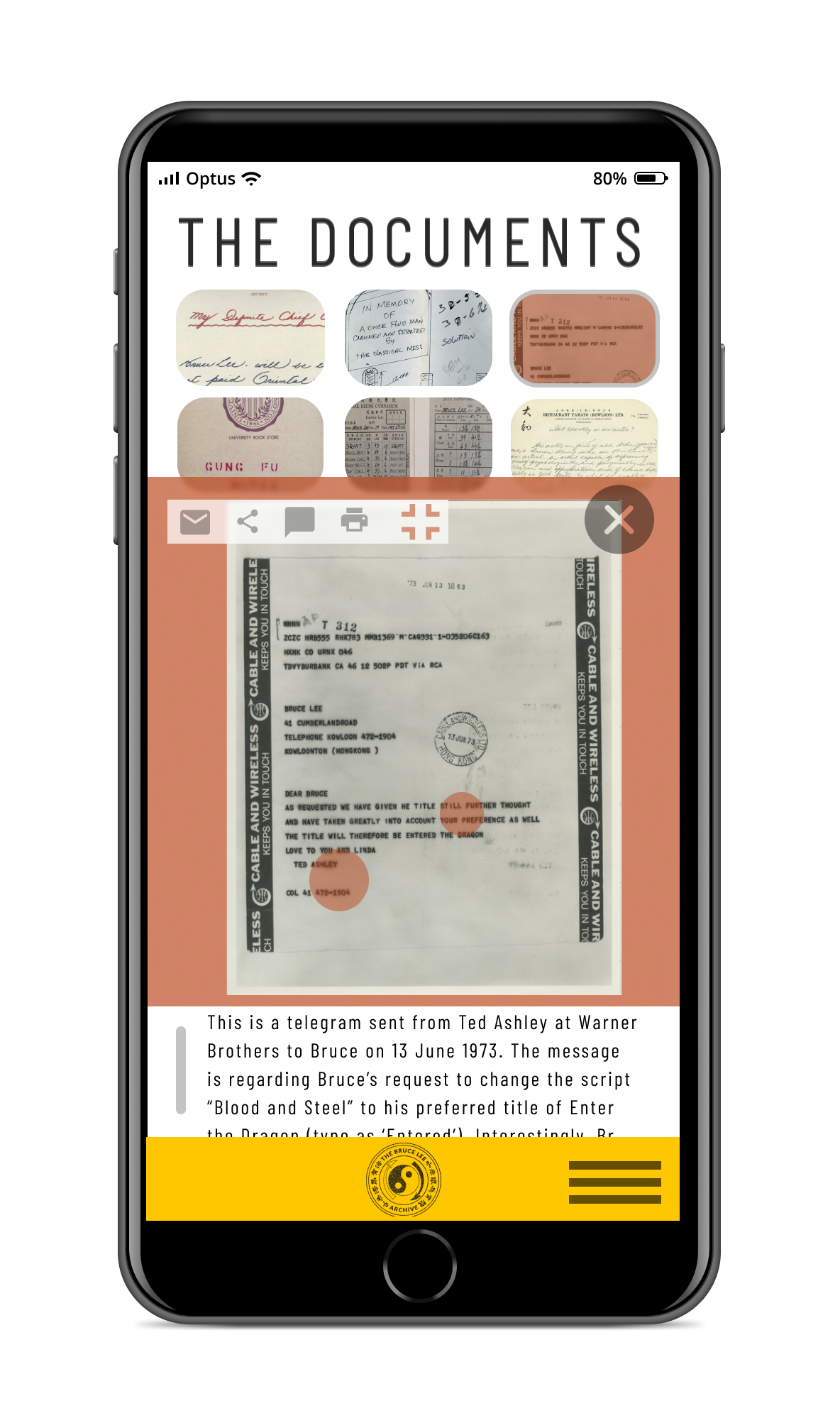 In collaboration with the content team we took this idea and decided to use the Stories section to cascade this same idea but intentionally group assets together to give users a sense of history in the same logic as the annotated red hot spots. This Story below shows a late’1950s, James Dean-worshipping era of Bruce. Users can jump around to hot spots in the text to bring up the correlating asset (demo video below).
In collaboration with the content team we took this idea and decided to use the Stories section to cascade this same idea but intentionally group assets together to give users a sense of history in the same logic as the annotated red hot spots. This Story below shows a late’1950s, James Dean-worshipping era of Bruce. Users can jump around to hot spots in the text to bring up the correlating asset (demo video below).